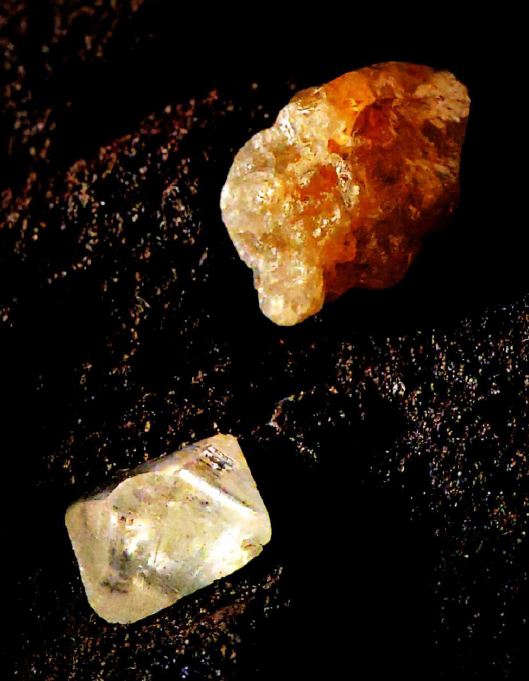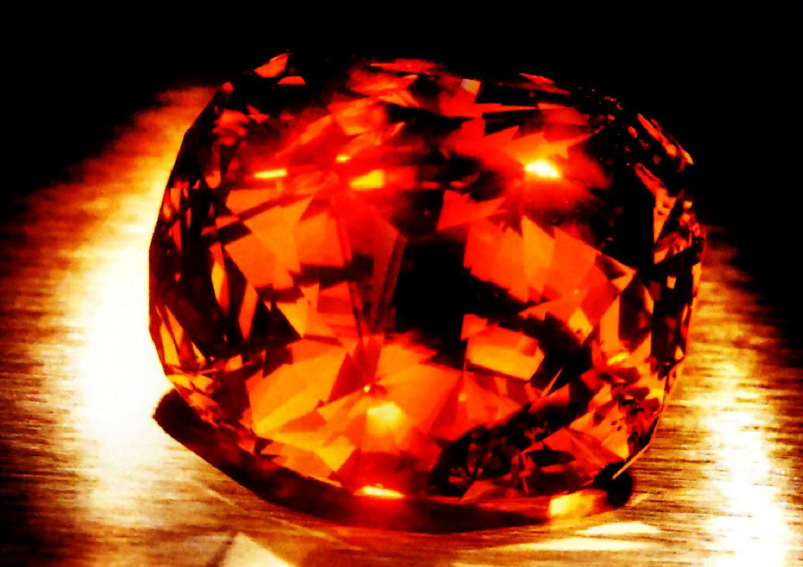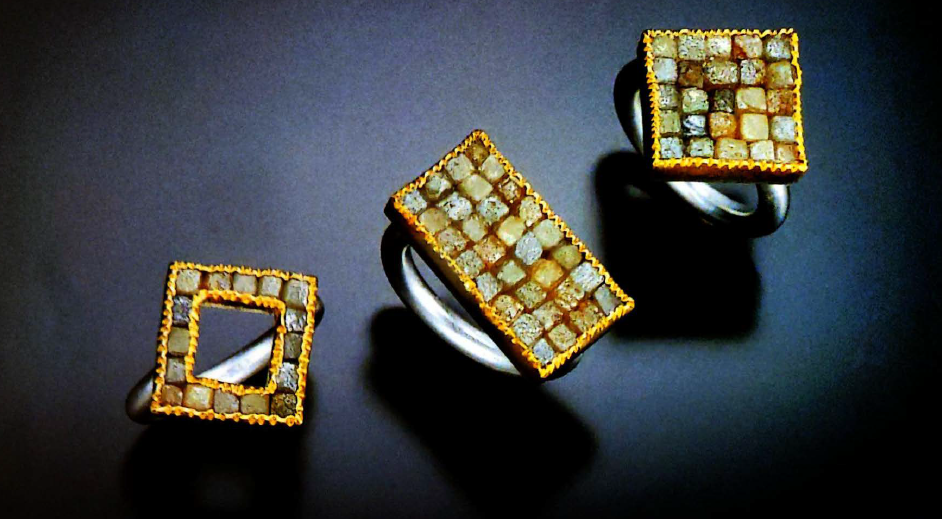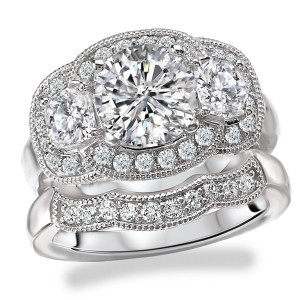Hey Everyone, this is a message from our friends in Diamonds Kingdom:
We diamonds have a couple confessions to make. We are not natural beauties and we are not forever. Yes, it's true. When people see us lying in a stream or in a pile of dirt, they usually think we're just another rock.
We look so ordinary. The first person that picked us up never dreamed we could both serve him and dazzle him. As time passed by, his descendants learned that we could cut any kind of rock or metal, but nothing could cut us except another diamond, so naturally we got drafted as saws, knives and drills. Yes, diamonds were used as tools long before they were cut as jewels.
 |
| Fig 1 A natural rough diamond covered with matrix-"skin" (upper right) and an octahedral-shaped diamond crystal (lower left). |
We're proud of the Taj Majal in India. Its intricate marble designs were cut by diamond tools. We're equally proud to see how indispensable we are to twentieth-century man. He uses us to drill for oil and gas, to mine ores, to fashion gemstones, to cut metal parts for cars, rockets and farm machinery. Dentists use us to drill teeth. Surgeons use us to cut bone and tissue.
When man discovered that we diamonds can drill and cut better than anything else, only began to recognize our potential. Outer space and defense programs take advantage of our ability to resist radiation, temperature and chemical damage. The electronics industry relies on us because not only can we conduct heat as well as any metal, we are also good electrical insulators.Think of us the next time you use a phone, a computer, a refrigerator, a television or an electnc hght.
Is it any wonder that companies like General Electric and Japan's Sumitomo Electric Industries have spent so much time and money learning to create diamonds? Yes, man-made diamonds are now a reality.
Most of you people are probably more familiar with our optical qualities-our transparency, brilliance and sparkle. These have not only earned us a reputation as the most important gemstone, they have also increased our practical value by malcing us useful for lenses, lasers and windows for outer space.
Maybe you think we're conceited for telling you how good we are. We're only trying to prove that we're not just another rock. Actually, we'd be the first to admit that we're only simple folk. Coal and pencil lead are our next of kin. All of us are nothing but carbon, and that's why you can't say that diamonds are forever. When you heat us in oxygen up to about 700° C (1292° Fahrenheit), we start turning to carbon dioxide or carbon monoxide.
We can understand, though, that someone who has a hard time making it past the age of 100 would think that a diamond that's a few million years old is forever; but to us, a few million years isn't much. Your scientists are finally beginning to realize that we existed long before your solar system did, now that they're studying us in meteorites.
Man also has a hard time imagining that something so simple and practical as a diamond can be transformed into a handsome work of art. ·Maybe that's why it took him so long to bring out our inner beauty. It's only been in the last few hundred years that he's cut tiny geometrical windows around us to reflect and let in light. Until about 1919, most of us looked a bit lackluster compared to the way we look today. Then the mathematician Marcel Tolkowsky published a complex formula for cutting us that made us more brilliant.
The Tolkowsky formula and other similar ones can only work well on diamonds that pass the jewel qualifying exam - an inspection so severe that about 60 % of all diamonds fail. This exam is a nightmare for us. The results determine whether we will bask under someone's appreciative eye or slave away as, perhaps, a drill.
After we've qualified as potential jewels, we undergo a beauty makeover that transforms us from ordinary looking rocks into extraordinary looking jewels. Makeover artists, also called diamond cutters, are in charge of this process. When they are finished, we start entering beauty contests. To get top scores in these contests, diamonds must have a lively and sparkling personality, an attractive shape, a clean character and individual charm. The judging is subjective and often there are hot debates over the scoring, particularly when large sums of prize money are at stake.
 |
| Fig. 2 The world's largest faceted diamond-the Golden Jubilee Diamond (545.67 carats). When it was found at South Africa's Premier Mine in 1986, it weighed 755.50 carats. Gabi Tolkowsky, a descendent of Marcel Tolkowsky, was commissioned to supervise the cutting of the stone. It took about two years to transform it into the beautiful golden (yellow-brown) diamond you see in this photograph. Photo from the Asian Institute of Gemological Sciences (AJGS Thailand). |
You might expect that the winners of these beauty contests have the best lives. More often than not they end up stuck in a safe deposit box, especially the large diamonds. It's true that life as a drill is a real bore, but life in a dark lonely box is not much better. Occasionally, some of the winners end up in museums and have a pretty good life, but those diamonds that end up the happiest are those worn day in and day out by you. Yet these are not normally the diamonds with the highest scores.
I suspect you find it strange that I talk about diamonds being happy. Plato and other great philosophers knew that we diamonds are living beings and have the same types of feelings as humans, but for some reason, most of you don't want to accept this fact. Let me assure you that we diamonds do have feelings, both positive and negative.
We are angered and hurt when people are duped into losing their life savings on us, when workers in the diamond industry are exploited, when arguments, robberies, murders and wars occur because of us. Somebody even told us that we were part of the cause of the French revolution. It had something to do with a diamond necklace scandal. But, on second thought, maybe our role in that scandal was more positive than negative. When terrible things happen because of us, blame yourselves for misusing diamonds, don't blame us.
 |
| Fig. 3 Industrial rough diamond cubes set in jewelry |
Fortunately life is not all bad; we do a lot of good. We create jobs for hundreds of thousands of people. We give people a means of escaping from oppressive governments. Non-jewel diamonds help supply you with food, energy, transportation, medical equipment and comfortable homes.
All of this good gives us great satisfaction, but there is something that gives us even more pleasure. It's when our mere presence makes man happy. What a joy it is to see the delight in the eye of newlyweds admiring their diamond wedding rings. What a joy it is to see a widow's grief interrupted by memories of some of the happiest moments of her life, as she looks down at her diamond engagement ring. What a joy it is to see people momentarily forget their everyday worries and frustrations and focus on thoughts of beauty and love, as they glance at us on their hands or wrists.
As long as you enjoy us and use us toward good ends, we diamonds don't expect anything in return for brightening up your lives. Well, maybe that's a bit of a lie. We will be bold enough to ask one little favor of you. Its this: If anyone ever tries to tell you that the diamond is just another rock, please tell him he's full of poppycock.















































